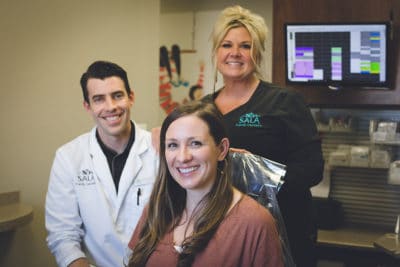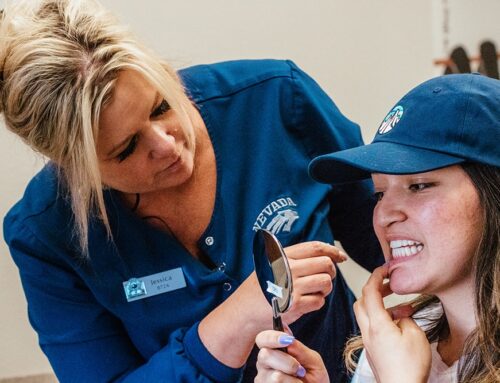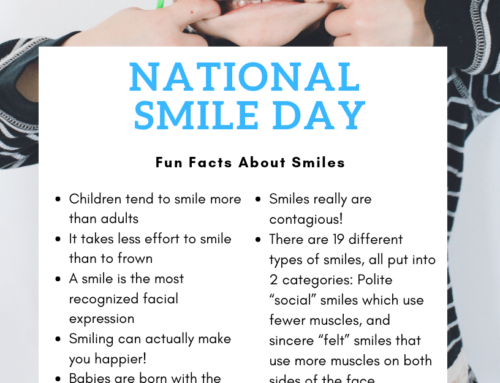
Q: At what age should my child typically see an orthodontist for the first time and what should I expect?
A: The American Association of Orthodontists recommends children get their first check-up with an orthodontists no later than 7 years old. At this age your child will have a mixture of baby and permanent teeth. An orthodontist is uniquely trained to monitor and evaluate the replacement of baby teeth with permanent teeth and determine whether a problem exists, or if one is developing. If an area of concern is noted during your child’s exam, we may suggest periodic observational visits, which may include x-rays and photos. The purpose of these visits are to keep an eye on how your child’s teeth, face and jaws are developing.The kinds of things that we will be watching include whether:
- Baby teeth are being lost in an appropriate timeframe
- Permanent teeth are coming in symmetrically, in the correct sequence, and at the correct time
- Upper and lower jaws are developing properly
- Permanent teeth have enough room to come in
- Permanent teeth are coming in and not impacted
If treatment is necessary to intercept a developing or existing problem, there is often an ideal time for treatment to begin. These return visits help determine the best time to start treatment.

Q: Should I wait for my child’s dentist to refer them to an orthodontist?
A: Here at Sala Family Dentistry we believe in comprehensive family dental care. This means that in addition to general dentists we have trained specialists in pediatric dentistry and orthodontics on staff. If your child receives regular dental care at Sala Family Dentistry then they are seen regularly by our pediatric dentist and orthodontist as needed to address any concerns as your child grows and develop. However, if your child is not seen by our pediatric orthodontic team, parents are often the first to recognize that something is not quite right about their child’s teeth or their jaws. A parent may notice that the front teeth don’t come together when the back teeth are closed, or that the upper teeth are sitting inside of the lower teeth. They may assume that their dentist is aware of the anomaly, and that the dentist will make a referral to an orthodontist when the time is right. A referral might not happen if the dentist isn’t evaluating the bite.
Q: Are dentists and orthodontists looking for the same problems?
A: Dentists are looking at the overall health of the teeth and mouth. He/she could be looking at how well the patient brushes and flosses, or if there are cavities. While dentists look at the upper and lower teeth, they may not study how the upper and lower teeth make contact. Orthodontists are looking at the bite, meaning the way teeth come together. This is orthodontists’ specialty. Orthodontists take the upper and lower jaws into account. Even if teeth appear to be straight, mismatched jaws can be part of a bad bite.
Q: If my child is seen by an orthodontist does that mean they are definitely getting treatment?
A: There are generally three outcomes of an initial check-up:
- No treatment is expected to be necessary.
- Treatment may be needed in the future, so the child will be followed periodically while the face and jaws continue to grow.
- There is a problem that lends itself to early treatment.
While there are many orthodontic problems that orthodontists agree are best treated after all permanent teeth have come in, early treatment can be in a patient’s best interests if their problem is one that could become more serious over time if left untreated. The goal of early treatment is to intercept the developing problem, eliminate the cause, guide the growth of facial and jaw bones, and provide adequate space for incoming permanent teeth. A patient may require a second course of treatment after all permanent teeth have come in to move those teeth into their best positions. The kinds of problems orthodontists may recommend treating while a child still has some baby teeth include:
- Underbites – when the lower front teeth are ahead of the upper front teeth
- Crossbites – when the jaw shifts to one side
- Very crowded teeth
- Excessively spaced teeth
- Extra or missing teeth
- Teeth that meet abnormally, or don’t meet at all
- Thumb-, finger-, or pacifier- sucking that is affecting the teeth or jaw growth
Some of these orthodontic problems are inherited, while others may result from accidents, dental disease, or abnormal swallowing. Early orthodontic treatment can take many forms. The orthodontist could prescribe a fixed or removable “appliance” – a device used to move teeth, change the position of the jaw, or hold teeth in place in order to bring about desirable changes. Sometimes no appliances are necessary. Rather, removal of some baby teeth may help the permanent teeth erupt better. The extractions will be timed to take best advantage of a patient’s growth and development.
Contact
Phone | (775) 376-7914
Email | info@salafamilydentistry.com
Hours
| Mon - Fri | 7:00am – 5:00pm |
| Saturday | 7:00am - 3:00pm |
| Sunday | Closed |
Location





